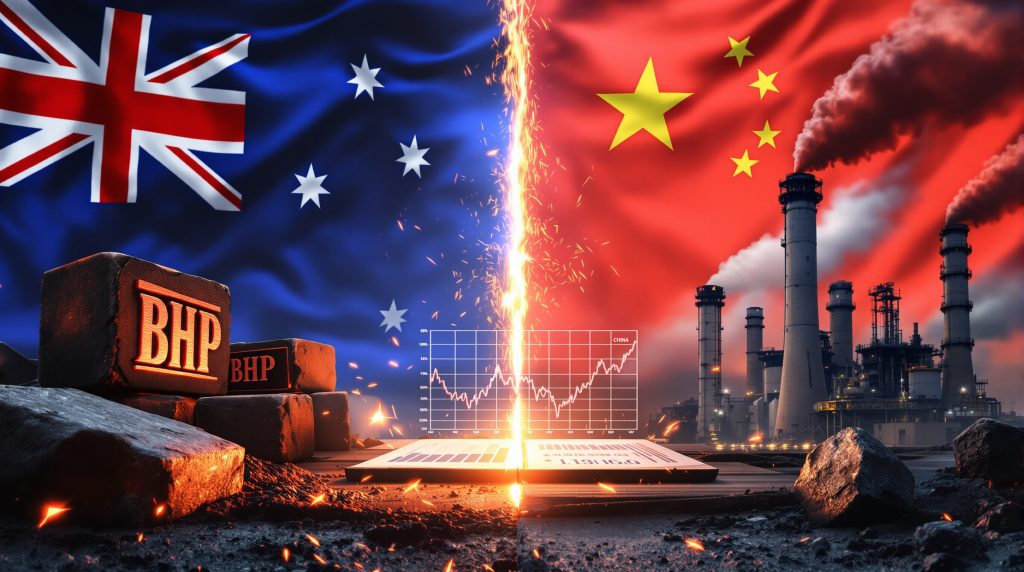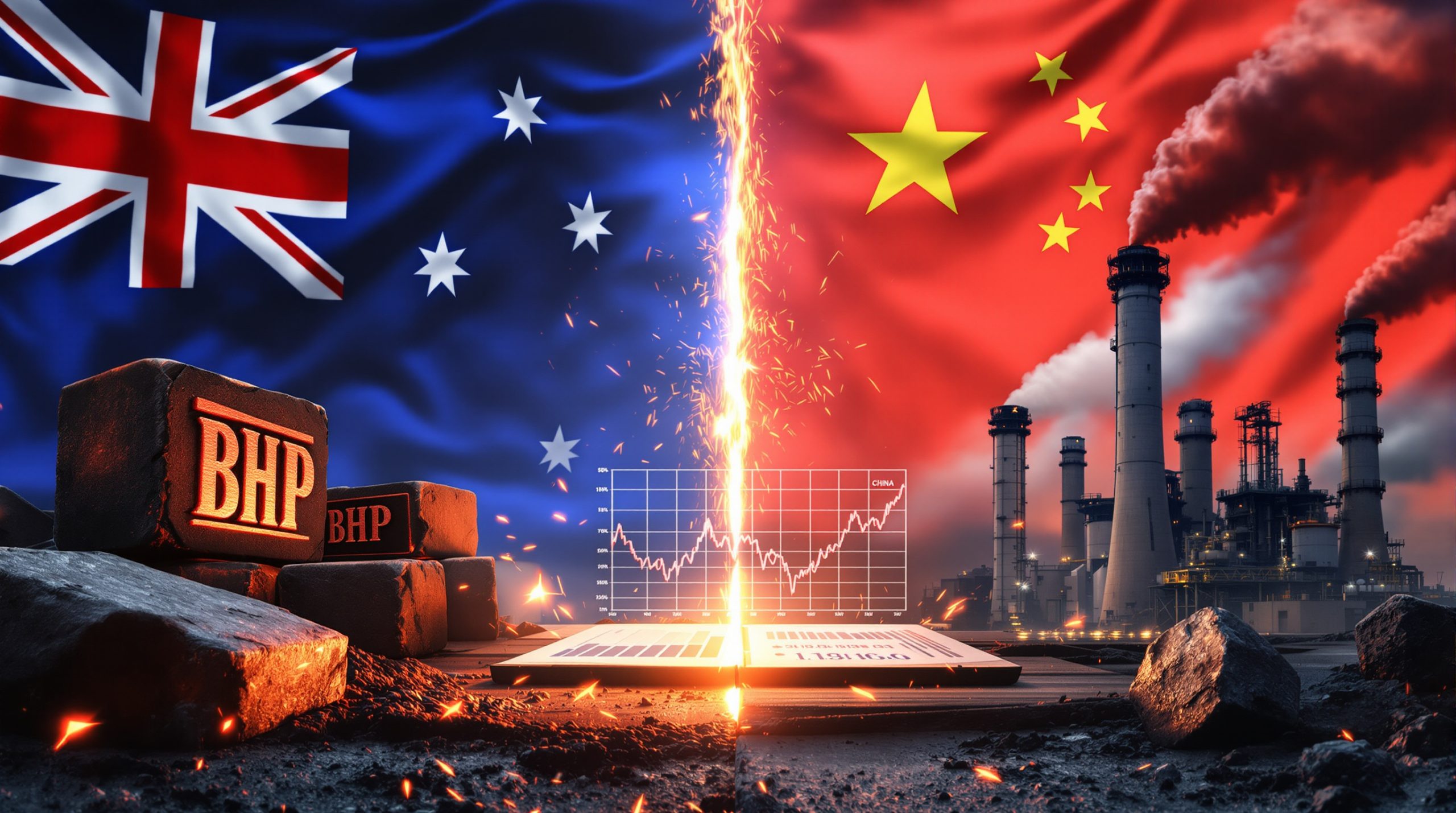The Power Dynamics of Iron Ore Negotiations: China's Steel Mills vs. BHP
In the high-stakes world of iron ore trading, a significant power struggle is unfolding between China's steel industry and one of the world's largest miners. Reports indicate Chinese authorities have instructed domestic steel mills to halt new iron ore purchases from BHP amid contentious contract negotiations, representing a dramatic shift in the traditional dynamics between suppliers and buyers in the global iron ore market.
This dispute centers on fundamentally different approaches to contract structure and pricing methodology. While BHP reportedly prefers annual contracts based on benchmark pricing, Chinese buyers are pursuing quarterly pricing mechanisms that could potentially secure lower rates for the vital steelmaking ingredient. The standoff highlights the increasingly complex relationship between Australia's resource giants and their largest customer.
How Are Iron Ore Pricing Negotiations Changing in 2025?
The iron ore market is witnessing a significant transformation in how prices are negotiated and contracts are structured. Recent developments indicate that Chinese authorities have directed steel mills to temporarily cease purchasing iron ore from BHP as tensions escalate over pricing mechanisms and contract terms.
China represents approximately 70% (1.2 billion metric tons) of total seaborne iron ore trade of around 1.7 billion metric tons in 2024, giving it substantial market influence. However, despite this commanding market position, industry analysts at Morningstar suggest China lacks short to medium-term negotiating power due to supply concentration among major producers.
The current iron ore price trends stands at approximately USD 105 per metric ton, according to recent market data. This pricing level serves as the backdrop for contentious negotiations between Chinese buyers seeking more favorable terms and major suppliers working to maintain profitable pricing structures.
This dispute reflects a fundamental shift from historical negotiation practices, with both sides attempting to secure advantageous positions in a market characterized by significant interdependence and evolving power dynamics.
What's Behind China's Strategic Move Against BHP?
The Formation of China Mineral Resources Group
In 2022, China established the China Mineral Resources Group (CMRG), a state-backed entity specifically designed to centralize iron ore purchasing power. This organization represents a strategic shift from previous decades when individual steel mills negotiated separately with mining giants.
The formation of CMRG marks a deliberate attempt to consolidate China's tremendous buying power in the iron ore market. As the world's largest steel producer and iron ore demand insights show, China has long sought greater influence over pricing dynamics in a market historically dominated by a handful of major suppliers.
By creating a unified purchasing entity, Chinese authorities aim to leverage their collective market position—representing approximately 70% of global seaborne iron ore demand—to secure more favorable pricing terms from major suppliers including BHP, Rio Tinto, Vale, and Fortescue Metals Group.
The Current Negotiation Deadlock
According to market reports, negotiations between CMRG and BHP have reached an impasse, with fundamental disagreements over pricing models creating a significant gap between the parties' positions:
| BHP's Position | China's Position |
|---|---|
| Annual pricing contracts | Quarterly pricing contracts |
| Based on historical benchmark prices | Based on current spot market rates |
| Higher price stability | Greater price flexibility |
| Less frequent renegotiation | More frequent price adjustments |
This pricing differential represents billions of dollars in potential revenue impact, explaining the high-stakes nature of these negotiations and China's apparent willingness to employ extraordinary measures to strengthen its position.
Can China Actually Pressure BHP Into Submission?
The Supply-Demand Reality Check
Despite China's apparent strong-arm tactics, market fundamentals suggest limited leverage in the short to medium term:
- China's steel industry requires approximately 1.2 billion metric tons of seaborne iron ore annually
- The "Big Four" iron ore producers collectively supply around 70% of global seaborne iron ore
- BHP alone contributes approximately 295 million metric tons annually to global supply
- Alternative supply sources cannot readily replace major producers' volumes
Market data from Morningstar reveals the concentrated nature of iron ore supply, with Rio Tinto (350 million metric tons), Vale (310 million), BHP (295 million), and Fortescue (195 million) collectively controlling approximately 70% of seaborne supply in 2024.
This supply concentration creates mutual dependency—while China needs iron ore, producers need the Chinese market. Industry analysts note that China has "nowhere else to go" to meet its substantial iron ore requirements, significantly limiting its immediate leverage despite its dominant market position.
China's Steel Production Constraints
China's steel industry faces several structural challenges that limit its negotiating power:
-
Blast furnace dominance: Most Chinese steel production relies on blast furnaces/basic oxygen furnaces that require iron ore as primary input
-
Limited scrap availability: While electric arc furnaces using scrap steel represent a theoretical alternative, China lacks sufficient domestic scrap supply
-
Production targets: Government industrial policies mandate certain steel output levels to support economic growth
-
Infrastructure dependency: China's continued focus on infrastructure development maintains high steel demand
These factors constrain China's ability to meaningfully reduce iron ore consumption in the short term, regardless of pricing disputes. As Morningstar analysts observe, "China's steelmaking capacity is primarily blast furnaces/basic oxygen furnaces, which require iron ore to produce steel," creating a fundamental dependency that cannot be quickly resolved.
What Are the Long-Term Implications for Iron Ore Markets?
Supply Expansion on the Horizon
The iron ore market appears poised for significant supply growth over the coming years:
- Simandou project (Guinea): Expected to add approximately 120 million metric tons once at full capacity (likely 2028-2029)
- Existing producer expansions: Vale, BHP, Rio Tinto, and Fortescue all have plans to increase production volumes
- Projected supply increase: Approximately 25% growth in seaborne iron ore supply by 2029 compared to 2024 levels
This supply expansion represents a potentially transformative shift in market dynamics. The Simandou project alone—when fully operational—will add volume equivalent to approximately 7% of current global seaborne iron ore trade, significantly altering supply-demand balances.
Industry analysts at Morningstar project that seaborne supply will rise approximately 25% by 2029 from 2024 levels, creating a substantially different market environment than what currently exists.
Price Forecast and Market Rebalancing
Market analysts project iron ore price forecast will decline from current levels of approximately USD 105 per metric ton to around USD 72 per metric ton by 2029. This forecast reflects:
- Increasing global iron ore supply from both existing and new projects
- Plateauing Chinese steel production as economic growth moderates
- Growing scrap utilization rates in China's steel industry
- Shifting construction and infrastructure investment patterns
- Declining steel intensity in China's economic development
These factors suggest China's negotiating leverage will likely improve over time, even if current tactics prove ineffective. As Morningstar notes, "China's steel production likely having peaked" combined with rising scrap use drives their view that iron ore prices will decline substantially in coming years.
How Does This Dispute Impact BHP's Business Strategy?
BHP's Diversification Efforts
BHP has been actively reshaping its portfolio to reduce dependency on any single commodity or market:
-
Copper expansion: The acquisition of Oz Minerals in 2023 strengthened BHP's copper position
-
Potash development: The Jansen project in Canada represents a strategic move into fertilizer markets
-
Petroleum divestment: BHP exited oil and gas by merging those assets with Woodside Energy in 2022
-
Geographic diversification: While Australia remains its core base, BHP continues expanding globally
This diversification strategy provides some insulation against commodity-specific disruptions, though iron ore remains a significant earnings contributor. BHP's fair value estimate stands at $40 per share according to Morningstar analysis, with shares trading at $41.89 as of October 2025.
Financial Impact Assessment
BHP's financial resilience amid pricing pressures stems from several factors:
- Low-cost production positioning: BHP's Western Australia iron ore operations maintain competitive cost structures
- Strong balance sheet: Conservative financial management provides flexibility during market disruptions
- Operational efficiency focus: Ongoing productivity improvements help offset price pressures
- Geographic advantages: Proximity to Asian markets offers freight cost advantages versus some competitors
These strengths suggest BHP can withstand temporary pricing pressures while maintaining profitability, even if at reduced levels. As Morningstar notes, BHP's "generally low-cost, high-quality assets mean BHP is likely to be one of the few miners that remains profitable through the commodity cycle."
China represents approximately 60% of BHP's sales in fiscal 2025, highlighting the importance of this market to the company's financial performance. However, BHP's diversified commodity portfolio and operational strength provide important buffers against market volatility.
What Are the Geopolitical Dimensions of This Trade Dispute?
The iron ore standoff extends beyond commercial negotiations into the broader Australia-China relationship. This dispute represents another chapter in the complex economic interdependency between the nations, where:
- Australia relies heavily on resource exports to China
- China depends on Australian raw materials for industrial development
- Political tensions occasionally spill over into trade relationships
- Both sides maintain significant economic incentives to resolve disagreements
The strategic iron ore asset importance to both nations creates a complex negotiating environment where commercial considerations intersect with broader geopolitical and economic priorities.
Much of BHP's revenue comes from assets in Australia, with Australia's iron ore leadership providing freight cost advantages compared to producers in regions like Africa and South America. This geographic reality creates both advantages and vulnerabilities within the current dispute.
How Should Investors Interpret These Developments?
Short-Term Market Reactions vs. Long-Term Fundamentals
Market participants should distinguish between immediate price volatility and underlying business fundamentals:
- Short-term share price movements often overreact to negotiation headlines
- Long-term iron ore demand remains supported by global urbanization and infrastructure development
- Major miners maintain strong competitive positions despite pricing pressures
- Diversified miners offer exposure to multiple commodity cycles
Investors focused on long-term fundamentals might view market overreactions as potential opportunities, while recognizing the genuine long-term challenges facing iron ore pricing.
Key Metrics to Monitor
Investors tracking this situation should focus on several indicators:
| Metric | Significance |
|---|---|
| Chinese port inventories | Rising inventories may indicate reduced purchasing activity |
| Spot price differentials | Premium/discount for different ore grades reflects quality preferences |
| Shipping rates and volumes | Real-time indicator of physical market activity |
| Steel mill profitability | Determines ability to absorb higher input costs |
| Policy announcements | Official statements from either side about negotiation status |
These metrics provide insight into the practical impact of the negotiation standoff beyond public posturing. Morningstar analysts advise investors to "focus on the bigger picture" rather than reacting to every rumor or short-term issue affecting the market.
Frequently Asked Questions About the China-BHP Iron Ore Dispute
Could China's ban on BHP iron ore purchases cause global supply disruptions?
While headline-grabbing, China's reported purchasing restrictions on BHP iron ore are unlikely to cause significant global supply disruptions. The fungible nature of iron ore means volumes rejected by one buyer can be redirected to others, potentially with price adjustments. Additionally, the interdependent nature of the market creates strong incentives for resolution before severe disruptions occur.
How does this dispute compare to historical iron ore pricing conflicts?
The current standoff represents an evolution of long-standing tensions in iron ore markets. Historically, iron ore prices were set through annual benchmark negotiations until approximately 2010, when the market shifted toward more spot-based pricing. China has repeatedly attempted to gain greater influence over pricing mechanisms, with the formation of CMRG representing its most coordinated effort to date.
What alternatives does China have to Australian iron ore?
China's alternatives to Australian iron ore include:
-
Brazilian supplies (primarily from Vale)
-
Domestic Chinese production (generally higher cost and lower quality)
-
Developing sources like Guinea's Simandou project (not yet operational at scale)
-
Increasing scrap utilization in steelmaking (limited by domestic availability)
None of these alternatives can fully replace Australian supply in the near term, limiting China's immediate leverage. As industry analysts note, "China has nowhere else to go to meet its iron ore needs" in the immediate future.
Conclusion: The Future of Iron Ore Pricing Power
The current dispute between China and BHP represents a significant test case for the evolving balance of power in global resource markets. While China's immediate leverage appears limited by supply realities, the longer-term trajectory suggests a gradual shift in negotiating dynamics as supply expands and Chinese demand growth moderates.
For market participants, this situation highlights the importance of understanding both immediate commercial tactics and longer-term structural trends in commodity markets. The outcome of this standoff will provide valuable insights into how resource negotiations might evolve in an increasingly multipolar global economy.
Both sides ultimately have strong incentives to find a workable compromise, given their mutual economic dependencies. The question remains whether this represents a temporary negotiating tactic or signals a more fundamental shift in how iron ore contracts are structured in the future.
Further Exploration
Readers interested in learning more about global iron ore markets can also explore related educational content from Morningstar Australia, which offers additional perspectives on resource sector dynamics and investment implications.
Want to Track Major ASX Mining Discoveries in Real Time?
Discover why significant mineral finds can lead to exceptional returns by exploring Discovery Alert's dedicated discoveries page, where their proprietary Discovery IQ model analyses ASX announcements to deliver actionable investment opportunities directly to subscribers.




